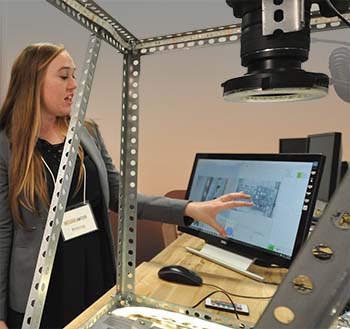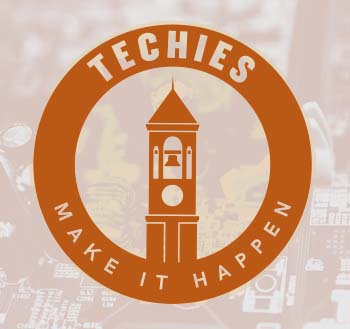Senior capstone projects
Seniors in the Purdue Polytechnic Institute take a powerful, active role in their own education by collaborating with one another on their final assignments. Senior capstones are two-semester, collaborative projects in which teams of Polytechnic seniors work with real-world clients to solve industry challenges. The capstones provide the culmination of the transformed Polytechnic experience. Students apply what they have learned as they research, design and deliver solutions to corporate and community partners.
When the college’s transformation began, only a handful of programs offered these capstone projects. Since then, all Polytechnic departments have integrated more and more capstones into the curriculum. For the fall 2018 cohort of students, 90 percent of the programs include two-semester capstone projects.
It’s never too early to be prepared
Recognizing the need to prepare Polytechnic students for the two-semester senior capstone project, the School of Engineering Technology added ECET 38001 to their curriculum. The concept: in year three, give engineering technology students a solid foundation in the skills and interactions they will need to succeed in their senior capstone project.
The junior-level class assigns the same project to each team. Student groups conduct research and analysis, set milestone schedules and develop the solution as a team.
The school is already seeing the benefits of introducing the capstone environment prior to the student’s senior year. Senior capstone teams are a week or more ahead of schedule compared to usual capstone progress before the inception of the junior-level prep class.
Frederick Berry, professor of engineering technology, works both with juniors in ECET 38001 and with senior capstone projects. This gives him a front-row view of the changes taking place in the Polytechnic and the preparedness of engineering technology seniors.
“This is how they will have to work in industry – as a collaborative team,” said Berry. “They learn to ask questions of themselves and others as they integrate individual and collective knowledge. They are ready to get to work.”
Polytechnic students land job offers with successful capstone
Lawrence Livermore National Laboratory (LLNL), a Department of Energy Laboratory, had an issue with the array of solar panels mounted to the roof of their building near San Francisco, California.
Working with students from other majors, you learn how to navigate differences with people who approach challenges in a different way.
- AJ HOCKER
BS ’18, transdisciplinary studies in technology
“As time goes on, the solar panels got covered in dust and debris,” explained Erik Schmig, LLNL’s telecommunications group supervisor. “That dust and debris caused the panels’ operational ability to quickly drop by as much as 30 percent and increased the chance of damage to the panels.”
Cleaning the solar panels was possible, but labor intensive and expensive. The laboratory needed a better cleaning system for their solar panels, and Schmig believed a better cleaning technology would benefit all users of solar technology. LLNL approached Purdue’s Polytechnic Institute with a capstone challenge to create an autonomous cleaning system that used little or no water, was energy-neutral and cost-effective, and could withstand extremes in weather conditions.
After studying the problem, Polytechnic students designed and built a mechanical cleaning system on rails mounted to the building’s solar panels. The cleaner featured spinning brushes to push dust, dirt and debris into a vacuum.
“The system they built had a considerable amount of electrical and mechanical technology, circuit boards, Raspberry Pi computers and software programming,” said Schmig. “This was truly a combined effort of project management, electrical, mechanical and software.”
LLNL, happy with the results of the capstone project, hired two of the students from the capstone team. The laboratory also has hired several summer interns and four other employees from their relationship with Purdue Polytechnic.
Kevin Mahoney has been LLNL’s nuclear materials superintendent since 1982. He spoke highly of the team and their work. “For this project, the Polytechnic students took a concept, created a mechanical design, built it, deployed it, captured the data and started over,” said Kevin Mahoney, LLNL’s nuclear materials superintendent. “They made it happen. It was solid, dependable work.”
All indications point to the successful transformation of the Polytechnic.
With a focus on innovative learning methods, hands-on experiences and industry partnerships, these 10 Elements of Transformation drive the Polytechnic Institute’s dedication to impactful technology education.



